Research on Electromagnetic Field, Eddy Current Loss and Heat Transfer in the End Region of Synchronous Condenser with Different End Structures and Material Properties
Abstract
:1. Introduction
2. Solution Domain Model of Electromagnetic Field in the End of Condenser
2.1. Physical Model of the End of Condenser
2.2. Three Dimensional Electromagnetic Field Mathematical Model of the End Region of the Condenser
3. Three-Dimensional Fluid–Solid Coupling Heat Transfer Model of the End Domain of the Condenser
Mathematical Model of Fluid–Solid Coupling Heat Transfer in the End of the Condenser
- (1)
- The conservation equation of mass is:where is the fluid density (kg/m3), is time (s), is the velocity vector (m/s).
- (2)
- The momentum conservation equation is:where , and are, respectively, the components of in the direction of , and , m/s, is the turbulent viscosity coefficient, (kg/(m·s)), is the fluid pressure, Pa, , and are general source terms.
- (3)
- The energy conservation equation is:where is the temperature, K; is the thermal conductivity, W/(m·K); is the specific heat capacity, J/(kg·K); is the power density calculated by FEA, W/m3.
- (4)
- The k-epsilon equation is:where is the diffusion factor, (m2/s3), is the kinetic energy of turbulence, (m2/s2); and are the Prandtl numbers. and are the constants. is the turbulence generation rate.
- (1)
- In this paper, the fluid flow state of the condenser researched is stable, and it is of a steady flow type.
- (2)
- The Reynolds number of the fluid in the condenser is much larger than 2300, and the flow is turbulent. The standard k-epsilon model is used to solve the fluid.
- (3)
- The velocity of fluid in the calculation domain of the condenser fluid field is far less than that of sound, so the compressibility of fluid is not considered.
4. Numerical Analysis of Multiple Physical Fields in the End of the Condenser
4.1. Electromagnetic Field Analysis in the End of the Condenser
4.2. Analysis of Calculation Results of Fluid–Solid Coupling Field in the End of the Synchronous Condenser
5. Temperature Test and Data Comparison
6. Conclusions
- (1)
- The radial magnetic flux density is the largest in the magnetic flux density component of the upper surface of the lower side of clamping plate under the original structure. Under the three schemes, the magnetic flux density of the inner circle and the outer circle of the clamping plate presents a sinusoidal regular change in the circumferential direction, and the magnetic flux density of the inner circle side is higher than that of the outer circle side. The magnetic flux density of the clamping plate under the original structure is the smallest.
- (2)
- The temperature near the chamber side is lower than that at the leeward side. The velocity of cooling medium at the inner circle side is higher than that at the outer circle side, but the temperature at the inner circle side is lower than that at the outer circle side.
- (3)
- The eddy current loss (4036 W) of the clamping plate of Scheme 2 is 3023 W higher than that of the original structure (1013 W), but the maximum temperature and minimum temperature of the clamping plate of Scheme 2 are 1.45 °C and 4.6 °C higher than those of the original structure, respectively. The eddy current loss (234 W) of the finger plate of Scheme 2 is 18.37% higher than that of the original structure (277 W), but the maximum temperature and minimum temperature of the finger plate of Scheme 2 are 1.66 °C and 0.54 °C higher than those of the original structure, respectively.
- (4)
- When Scheme 2 is adopted, the eddy current loss increases more than that of the original structure, but the temperature increases in the clamping plate, finger plate and other structural parts are less. It can be seen that when the copper shield is removed and the steel clamping plate is replaced by the aluminum clamping plate, the end structure can be simplified and the material of copper shield can be saved. The aluminum clamping plate itself can play a shielding role. Due to the temperature increase being lower, other simple and feasible methods can be adopted to reduce the temperature, such as increasing the fan inlet air volume.
Author Contributions
Funding
Conflicts of Interest
References
- Bian, X.; Liang, Y.P. Circuit Network Model of Stator Transposition Bar in Large Generators and Calculation of Circulating Current. IEEE Trans. Ind. Electron. 2015, 62, 1392–1399. [Google Scholar] [CrossRef]
- Gozdowiak, A. Faulty Synchronization of Salient Pole Synchronous Hydro Generator. Energies 2020, 13, 5491. [Google Scholar] [CrossRef]
- Wang, L.K.; Huo, F.Y.; Li, W.L. A Novel Dual Three-Phase Permanent Magnet Synchronous Motor with Asymmetric Stator Winding. IEEE Trans. Magn. 2013, 49, 939–945. [Google Scholar] [CrossRef]
- Tao, D.J.; Zhou, K.L.; Lv, F.; Dou, Q.P.; Wu, J.X.; Sun, Y.T.; Zou, J.B. Magnetic Field Characteristics and Stator Core Losses of High-Speed Permanent Magnet Synchronous Motors. Energies 2020, 13, 535. [Google Scholar] [CrossRef] [Green Version]
- Ding, S.Y.; Li, Z.J. Analysis of Fluid Field Characteristics and Structure Optimization inside Stator Domain for Air-cooled Turbo-generator. In Proceedings of the 2020 12th IEEE PES Asia-Pacific Power and Energy Engineering Conference (APPEEC), Nanjing, China, 20–23 September 2020; pp. 1–5. [Google Scholar]
- Traxler-Samek, G.; Zickermann, R.; Schwery, A. Cooling airflow, losses, and temperatures in large air-cooled synchronous machines. IEEE Trans. Ind. Electron. 2010, 57, 172–180. [Google Scholar] [CrossRef]
- Ding, S.Y.; Zhang, X.F.; Guan, T.Y. Analysis of Heat Transfer Performance for Megawatt Wind Generator in High Altitude Extreme Conditions. In Proceedings of the 2014 17th International Conference on Electrical Machines and Systems (ICEMS), Hangzhou, China, 22–25 October 2014; pp. 2340–2346. [Google Scholar]
- Zhang, L.L.; Ling, Y.P.; Bian, X. Analysis of Magnetic Flux Density of Air Gap in Turbo-Generators Using Equivalent Magnetic Network Method. In Proceedings of the 2019 22nd International Conference on Electrical Machines and Systems (ICEMS), Harbin, China, 11–14 August 2019; pp. 1–5. [Google Scholar]
- Ling, Y.P.; Bian, X.; Yu, H.H. Analytic Algorithm for Strand Slot Leakage Reactance of the Transposition Bar in an AC Machine. IEEE Trans. Ind. Electron. 2014, 61, 5232–5240. [Google Scholar] [CrossRef]
- Jing, T.T.; Liu, G.H.; Zhou, H.W. Simplified Thermal Modeling of Fault-Tolerant Permanent-Magnet Motor by Using Lumped Parameter Network. In Proceedings of the 2014 IEEE Conference and Expo Transportation Electrification Asia-Pacific (ITEC Asia-Pacific), Beijing, China, 31 August–3 September 2014; pp. 1–5. [Google Scholar]
- Zhao, W.X.; Cao, D.H.; Ji, J.H. A Generalized Mesh-Based Thermal Network Model for SPM Machines Combining Coupled Winding Solution. IEEE Trans. Ind. Electron. 2021, 68, 116–127. [Google Scholar] [CrossRef]
- Ling, Y.P.; Yu, H.H.; Bian, X. Finite-Element Calculation of 3-D Transient Electromagnetic Field in End Region and Eddy-Current Loss Decrease in Stator End Clamping Plate of Large Hydrogenerator. IEEE Trans. Ind. Electron. 2015, 62, 7331–7338. [Google Scholar] [CrossRef]
- Demir, Y.; Aydin, M. A Novel Dual Three-Phase Permanent Magnet Synchronous Motor with Asymmetric Stator Winding. IEEE Trans. Magn. 2016, 52, 8105005. [Google Scholar] [CrossRef]
- Tong, W.M.; Dai, S.H.; Wu, S.N. Performance Comparison Between an Amorphous Metal PMSM and a Silicon Steel PMSM. IEEE Trans. Magn. 2019, 45, 8102705. [Google Scholar] [CrossRef]
- Han, J.C.; Zheng, P.; Sun, Y.T. Influence of Electric Shield Materials on Temperature Distribution in the End Region of a Large Water–Hydrogen–Hydrogen-Cooled Turbogenerator. IEEE Trans. Ind. Electron. 2020, 67, 3431–3441. [Google Scholar] [CrossRef]
- Huo, F.Y.; Hai, J.C.; Li, W.L. I Influence of Copper Shield Structure on 3-D Electromagnetic Field, Fluid and Temperature Fields in End Region of Large Turbogenerator. IEEE Trans. Ind. Electron. 2013, 28, 832–840. [Google Scholar]
- Fan, Z.; Yi, H.; Xu, J.; Xie, K.; Qi, Y.; Ren, S.; Wang, H. Performance Study and Optimization Design of High-Speed Amorphous Alloy Induction Motor. Energies 2021, 14, 2468. [Google Scholar] [CrossRef]
- Wang, L.K.; Li, W.L.; Huo, F.Y. Influence of Underexcitation Operation on Electromagnetic Loss in the End Metal Parts and Stator Step Packets of a Turbogenerator. IEEE Trans. Energy Convers. 2014, 29, 748–757. [Google Scholar] [CrossRef]
- Wang, L.K.; Li, W.L. Assessment of the Stray Flux, Losses, and Temperature Rise in the End Region of a High-Power Turbogenerator Based on a Novel Frequency-Domain Model. IEEE Trans. Ind. Electron. 2018, 65, 4503–4513. [Google Scholar] [CrossRef]
- Huo, F.Y.; Li, W.L.; Wang, L.K. Numerical Calculation and Analysis of Three-Dimensional Transient Electromagnetic Field in the End Region of Large Water–Hydrogen–Hydrogen Cooled Turbogenerator. IEEE Trans. Ind. Electron. 2014, 61, 188–195. [Google Scholar] [CrossRef]
- Li, W.L.; Han, J.C.; Huo, F.Y. Influence of the End Ventilation Structure Change on the Temperature Distribution in the End Region of Large Water–Hydrogen–Hydrogen Cooled Turbogenerator. IEEE Trans. Energy Convert. 2013, 28, 278–288. [Google Scholar]
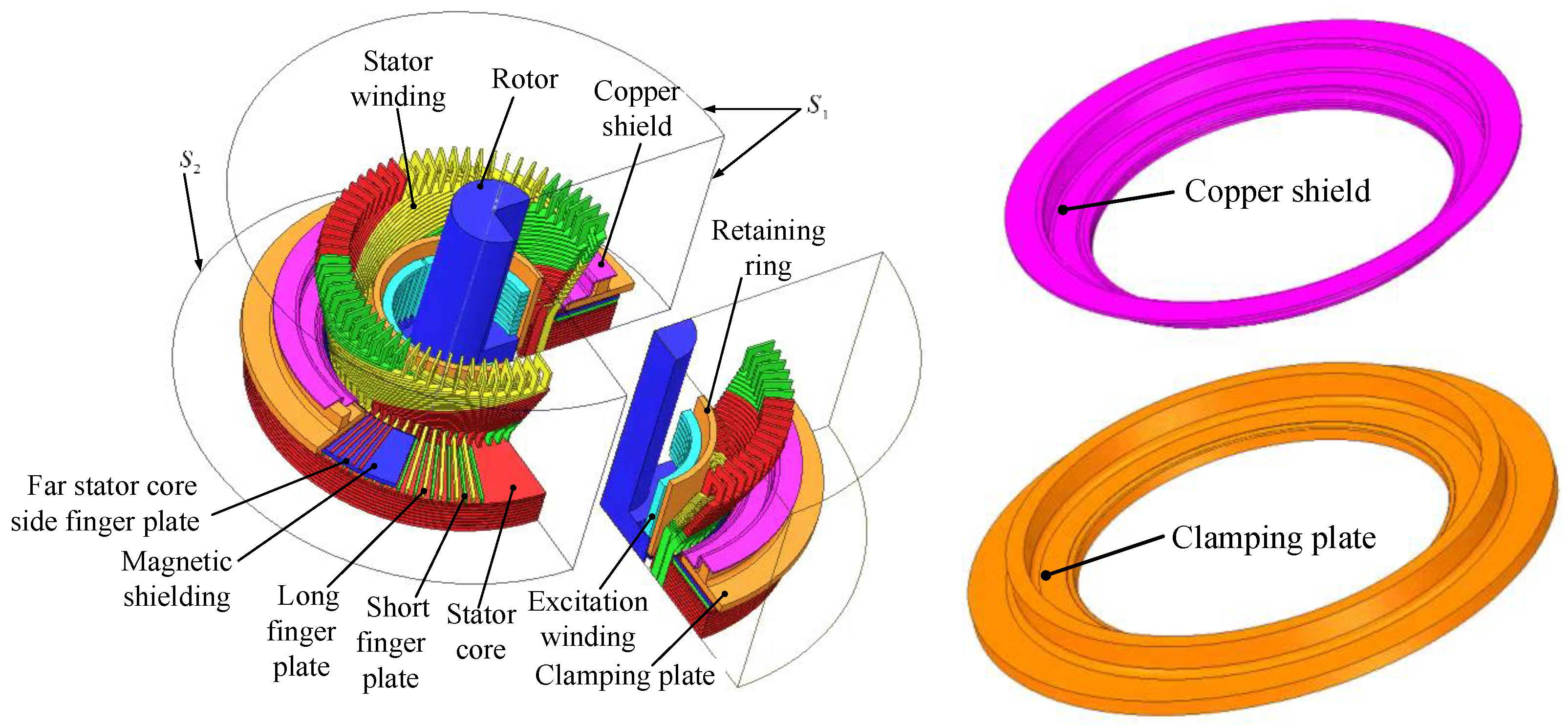



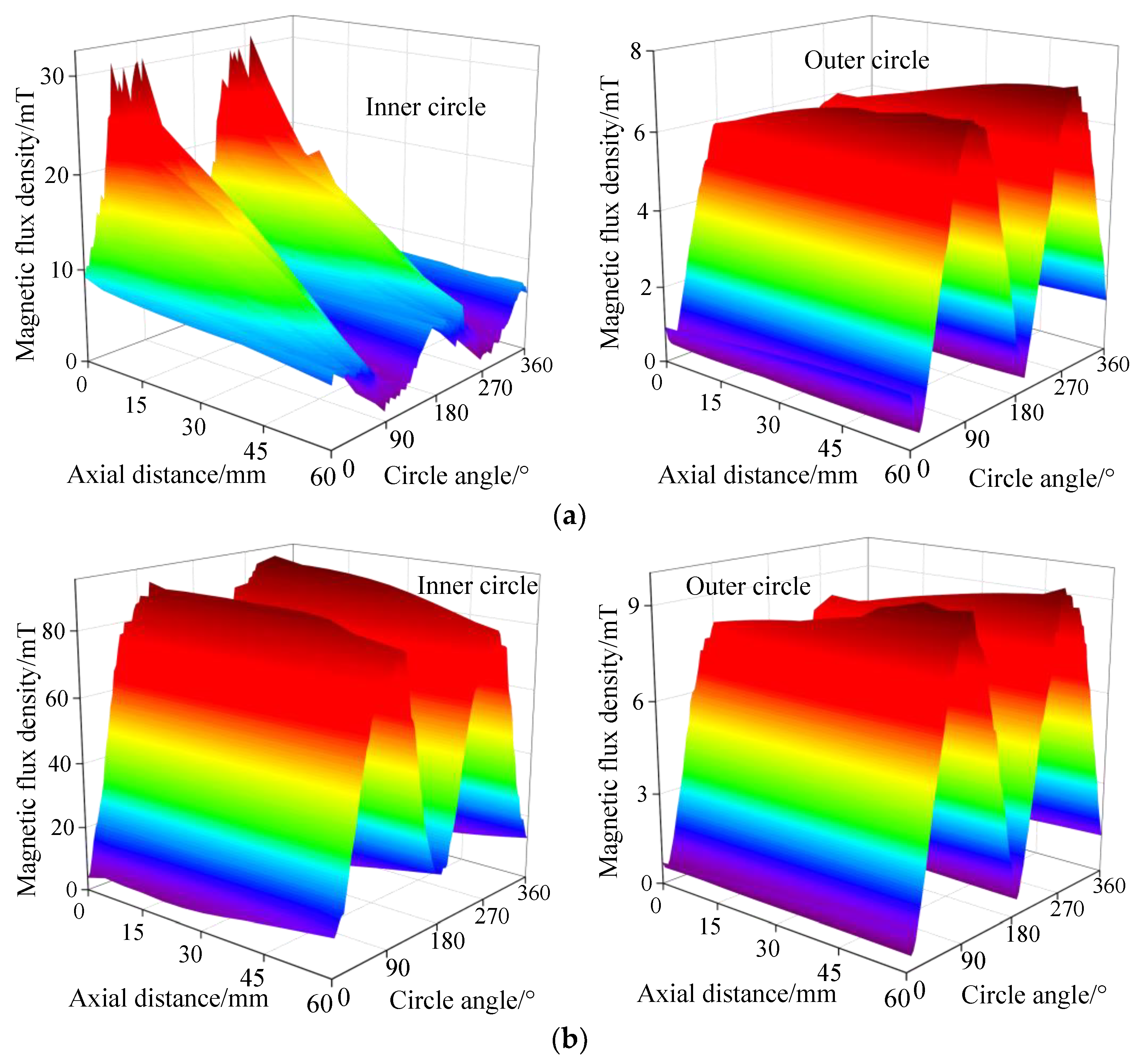


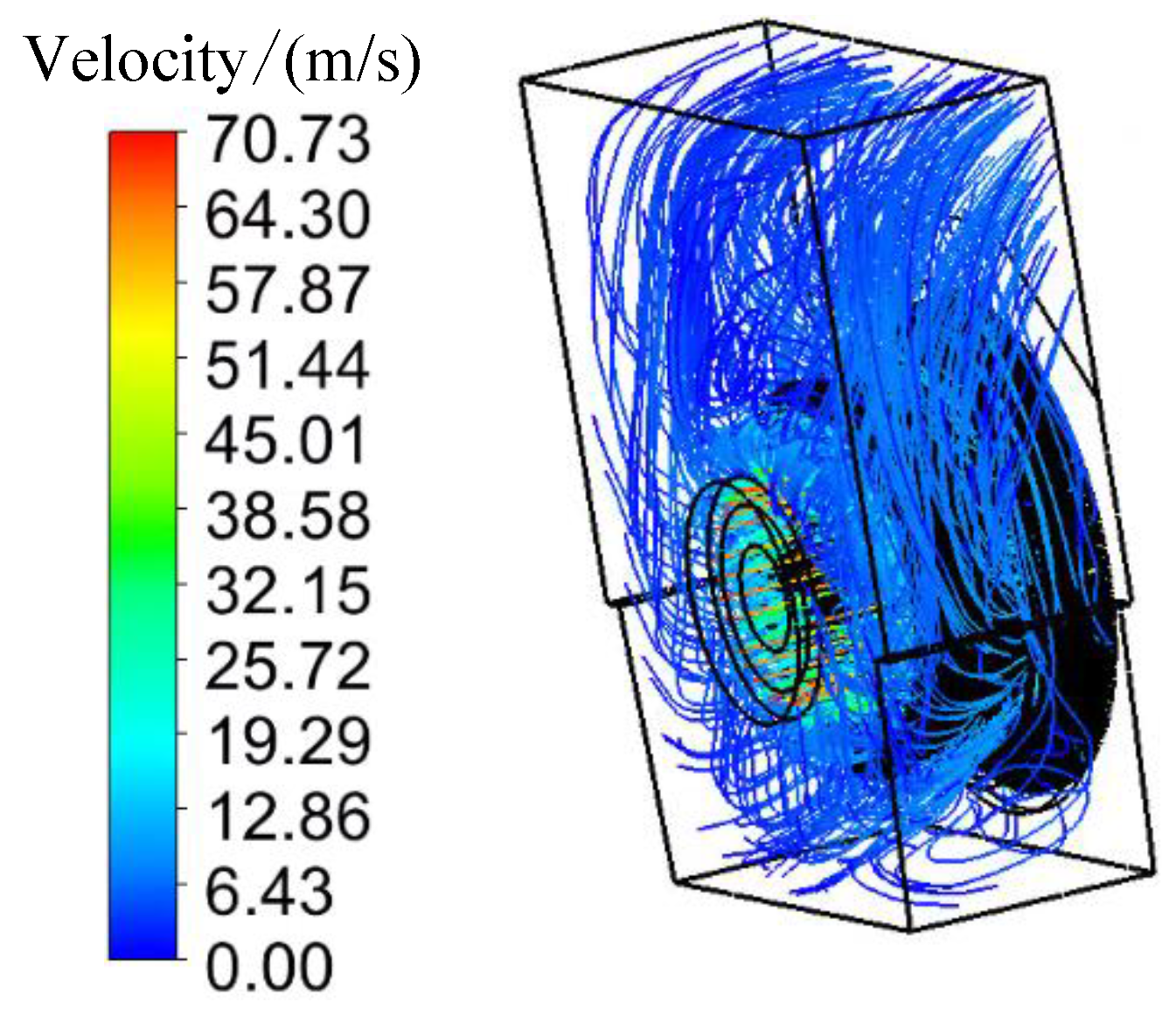

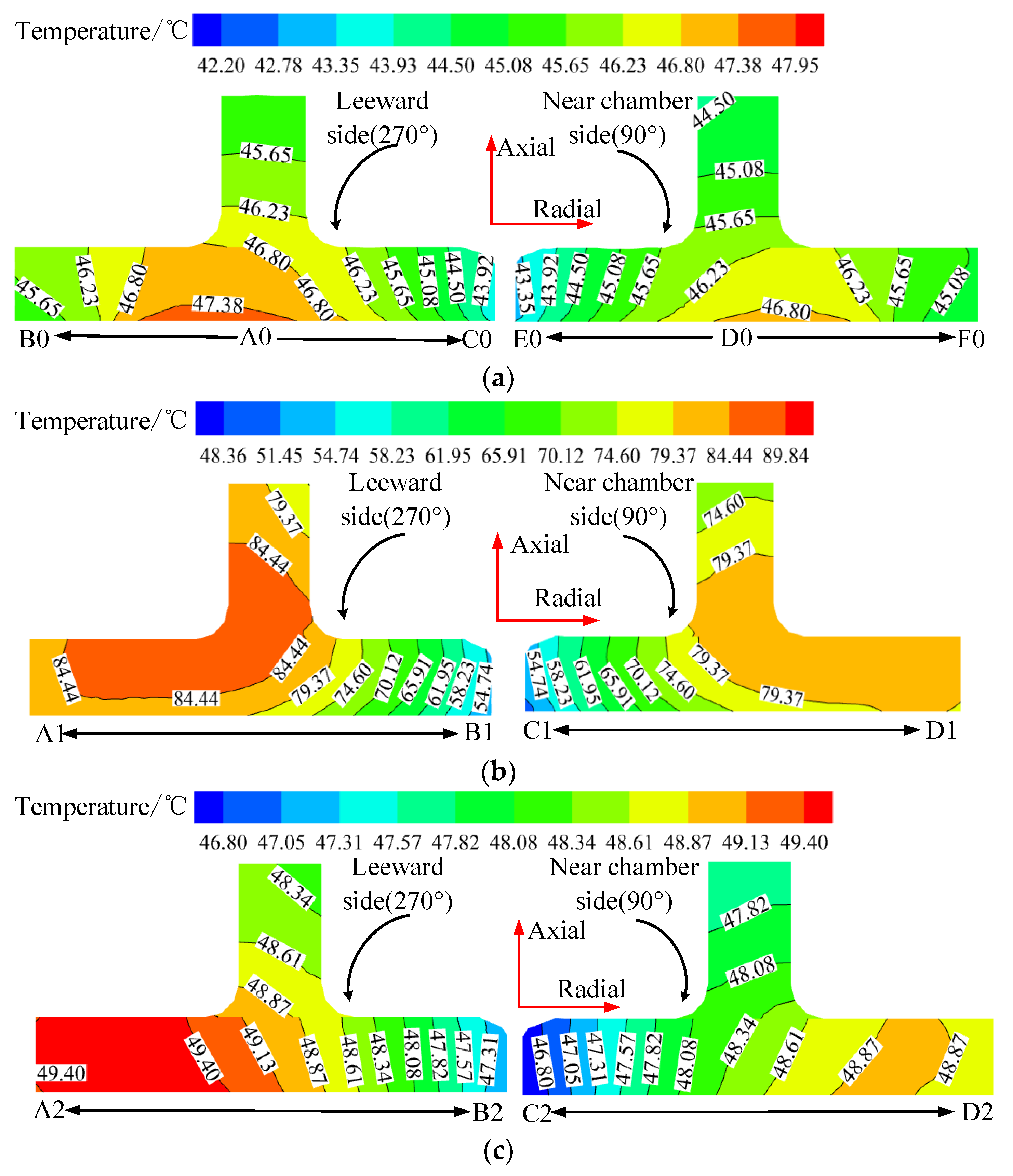

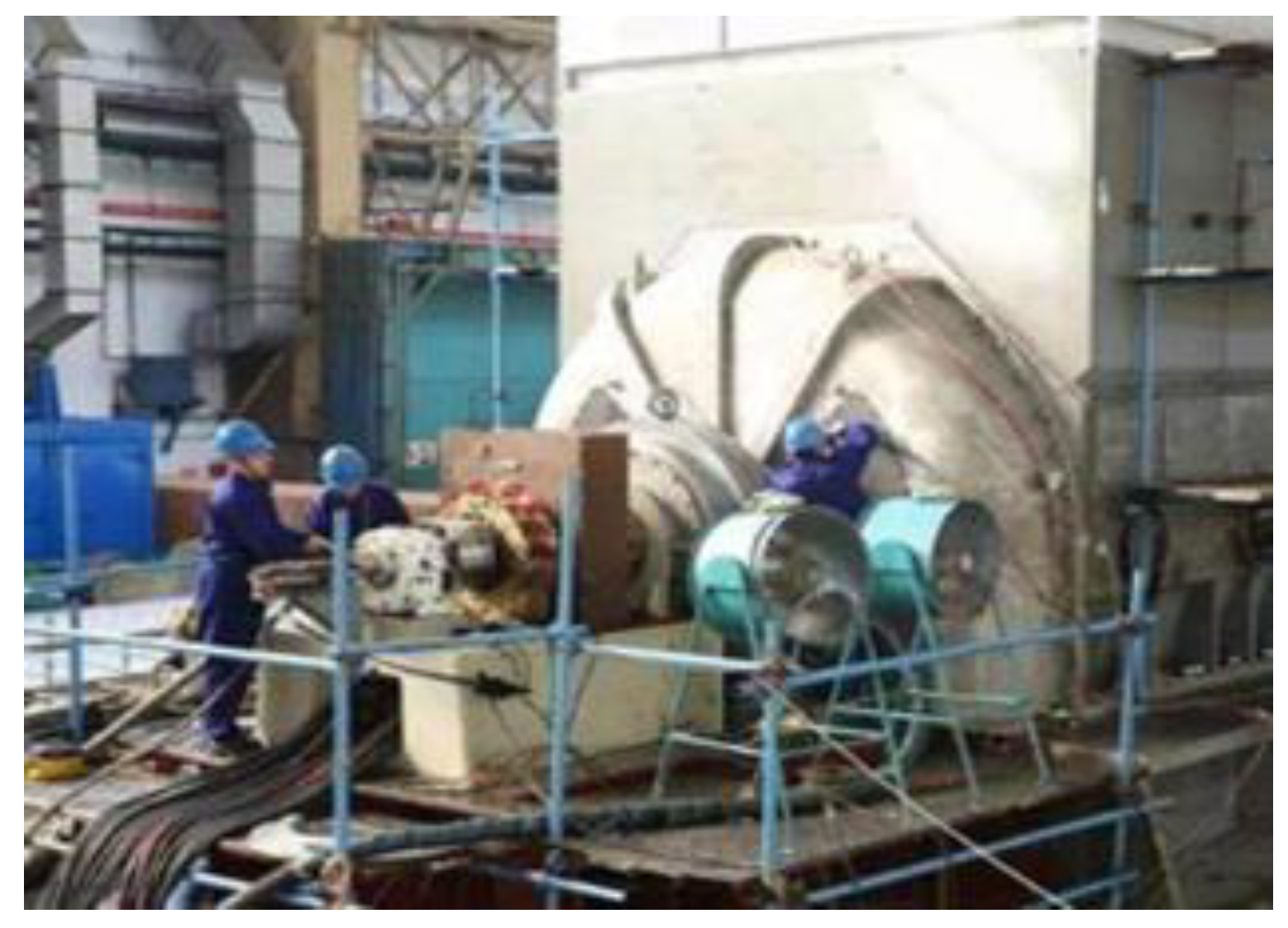
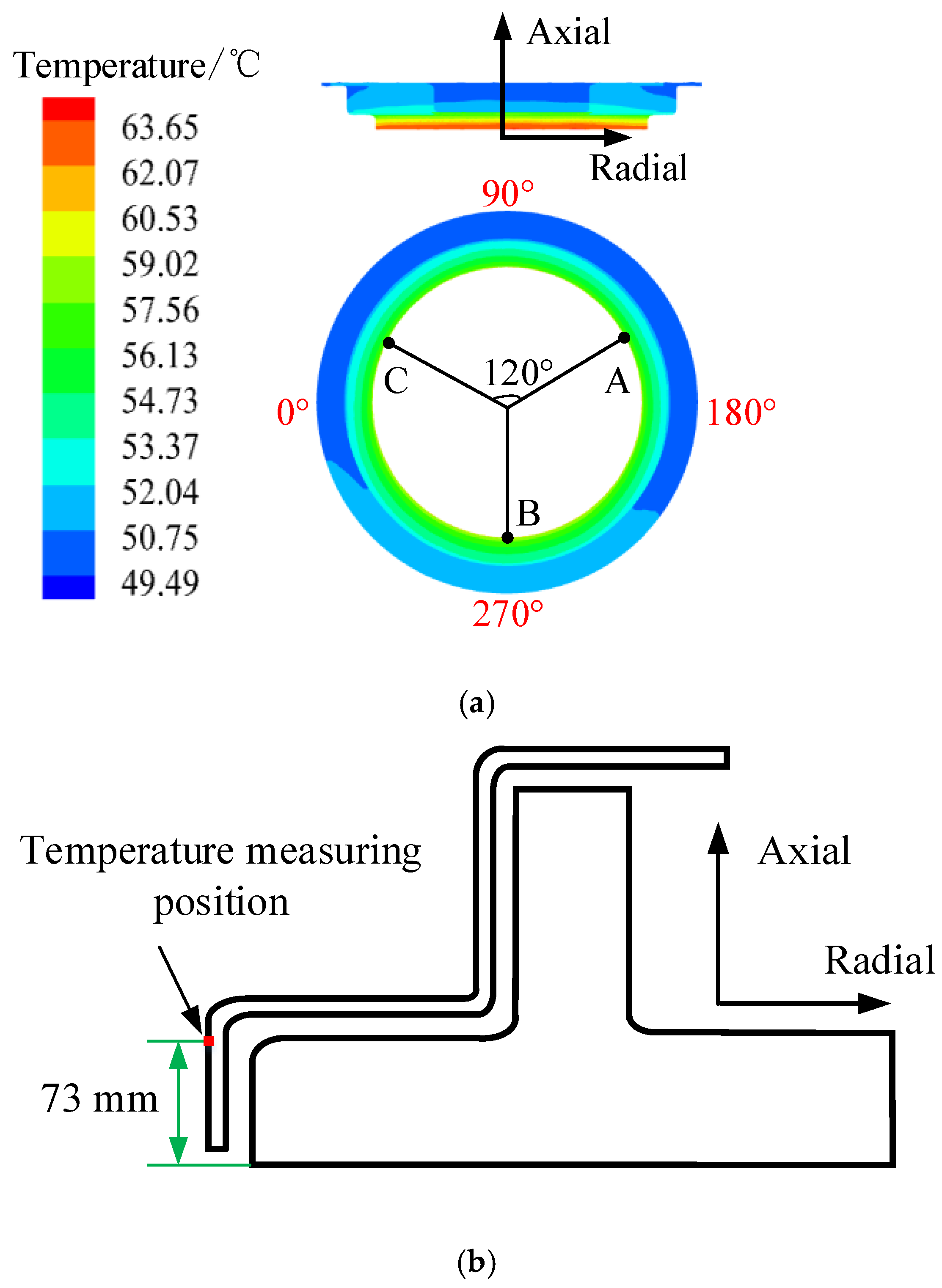
| Parameters | Value |
|---|---|
| Rated Capacity/Mvar | 300 |
| Rated voltage/kV | 20 |
| Rated current of stator/A Rated rotate speed/ | 8660 3000 |
| Rated excitation current/A Stator external diameter/mm | 2381 2950 |
| Number of stator slots | 72 |
| Number of poles | 2 |
| Parameters | Value |
|---|---|
| 1.30 | |
| 1.30 | |
| 1.44 1.92 | |
| Energy Prandtl number Wall Prandtl number | 0.85 0.85 |
| Structure | Position | Measured Value/°C | Calculated Value/°C |
| Copper shield | A | 57.9 | 58.7 |
| B | 58.3 | 59.4 | |
| C | 54.2 | 58.6 |
Publisher’s Note: MDPI stays neutral with regard to jurisdictional claims in published maps and institutional affiliations. |
© 2021 by the authors. Licensee MDPI, Basel, Switzerland. This article is an open access article distributed under the terms and conditions of the Creative Commons Attribution (CC BY) license (https://creativecommons.org/licenses/by/4.0/).
Share and Cite
Bi, X.; Wang, L.; Marignetti, F.; Zhou, M. Research on Electromagnetic Field, Eddy Current Loss and Heat Transfer in the End Region of Synchronous Condenser with Different End Structures and Material Properties. Energies 2021, 14, 4636. https://doi.org/10.3390/en14154636
Bi X, Wang L, Marignetti F, Zhou M. Research on Electromagnetic Field, Eddy Current Loss and Heat Transfer in the End Region of Synchronous Condenser with Different End Structures and Material Properties. Energies. 2021; 14(15):4636. https://doi.org/10.3390/en14154636
Chicago/Turabian StyleBi, Xiaoshuai, Likun Wang, Fabrizio Marignetti, and Minghao Zhou. 2021. "Research on Electromagnetic Field, Eddy Current Loss and Heat Transfer in the End Region of Synchronous Condenser with Different End Structures and Material Properties" Energies 14, no. 15: 4636. https://doi.org/10.3390/en14154636







